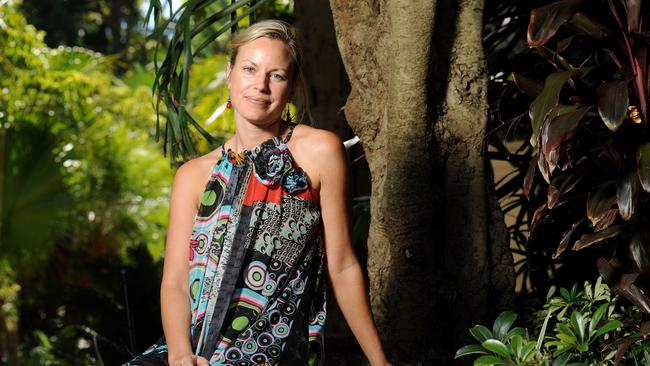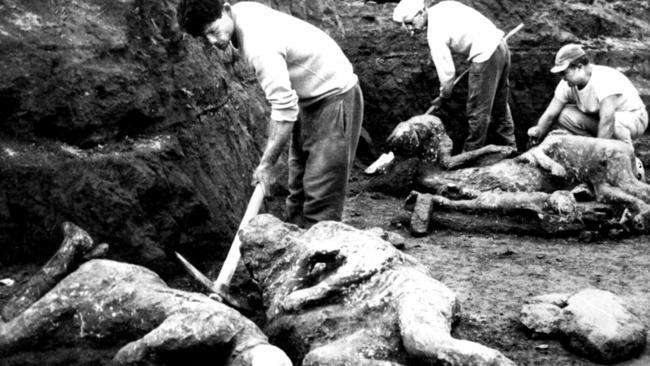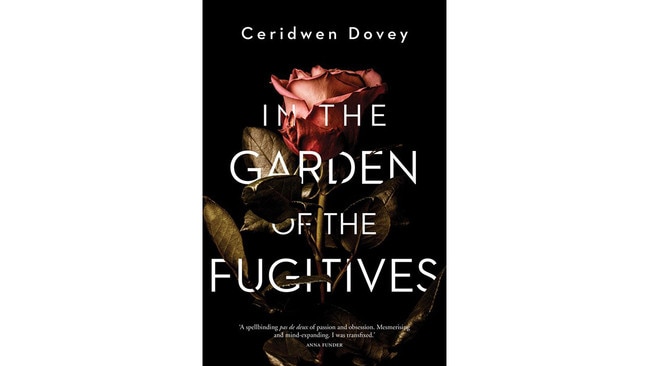Ceridwen Dovey, In the Garden of the Fugitives: caught in the moment
Competing memories of excavations uncovered in Ceridwen Dovey’s second novel illuminate a compelling archeology of souls.

Freud was fascinated by the classical world from boyhood. He collected antiquities, admired the work of Heinrich Schliemann, the 19th-century discoverer of Troy, and often compared the work of analysis with that of archeology. But there was a point where, in Freud’s thinking, the two disciplines parted ways.
He believed that the analyst of the human subconscious worked under more favourable conditions than the archeologist. Analysis has at its disposal material “which can have no counterpart in excavations”, since a dig site is partial, layered, rendered down to fragments by time and the elements. Our personalities, by contrast, are inviolate chambers, built from memory and the repetitions of reactions dating from earliest infancy.
Only in the rarest instances, he continues, does an archeological find correspond neatly with the complete record that is the psyche. His example of the exception that proves his rule is the Roman city of Pompeii, buried by the eruption of Mount Vesuvius in AD 79.
Here, he writes, just like the human mind, “all of the essentials are preserved; even things that seem completely forgotten are present somehow and somewhere, and have merely been buried and made inaccessible to the subject”.
Ceridwen Dovey’s second novel makes dark sport with this comparison. Half its pages are given over to an account by an elderly American, dying of an undisclosed illness, of time spent as the assistant to an archeologist working in Pompeii during the 1970s, in particular at the place known as the Garden of the Fugitives.
It was here that 13 body-shaped chambers — the largest number found during the city’s excavation — were discovered beneath the ancient layer of hardened ash and pumice.
The gaps were subsequently filled with plaster, yielding a series of bodies writhing or curled up, caught in the moment of their deaths.

These ghosts of Vesuvius are real enough: you can visit them today in their glass and timber shed. But their presence in this novel is equivocal. For the American, the bodies are aesthetic objects:
The longer I looked, the more beautiful I found the casts. I could have stood there and gazed at them for hours. They seemed to me like sculptures arranged for maximum emotional effect, as if death had artistic designs of its own. Any one of the bodies would have been arresting, but together they formed a sublime work of art.
But for others, these plaster casts are violations of some final privacy and impediments to an objective understanding of the lives they claim to represent. Another archeologist, a woman, as if intuiting the American’s private thoughts, tells the story of the Italian man who first popularised the statues. He apparently shaped a highly melodramatic story around the Fugitives, an extrapolation from his own imagination ungrounded in verifiable data regarding his subjects, their gender, age, health, nutrition, injuries or illnesses.
All very moving. But none of it is based on fact. We can never know the truth about these thirteen fugitives. I cannot access their bones without destroying the plaster casts. This is why I no longer agree with the practice of making casts like these. And it’s why I decided to focus on the skeletons of Pompeii instead, most of which have been stored without classification or care.
Importantly for what follows, it is the man who is permitted the gush of admiration for what is lovely. It is a female archeologist who must, of necessity, stick to the facts — lest she lose the respect of her male peers. This divided response and its gendered nature ripples out through the entire novel.
The plaster statues into which the man projects his desires; the skeletons that are the real fate and ultimate register of our bodily life: the fugitives in their garden come to serve as a metaphor for so much more than their sad collective end.
The narrative set-up is straightforward enough. Royce is an east coast American of the old school, scion of a wealthy family — rich enough to generously endow the college he once attended.

Vita is a woman in early middle age, Australian by residence but South African by birth and upbringing, who attended that same college 20 years ago.
Back then, Vita, ambitious and promising, attracted Royce’s attention. He helped her gain a lucrative ongoing career support grant from the endowment he established, but there were strings attached.
When the novel opens, the two have been estranged for years. Royce emails Vita to tell her that he is dying. Intimations of mortality have inspired in him a nostalgia for the past, along with a desire to clear the decks.
Life circumstance has also made Vita open to his entreaty. She is entering her 40s bereft of the ambition and also, perhaps, the sexual clout her youth afforded her: a command she once mistook for feminist empowerment. She replies, albeit coolly, and the pair begin sketching out what was shared in their past and what has occurred while they were apart.
So we are faced with a basic exchange of emails between a dying old man and the younger woman he once helped for ambiguous reasons. Yet this correspondence is anything but simple.
This is a two-hander the way Mamet or Pinter would play it on the stage: filled with slippages in character and narrative instabilities that manipulate our sympathies and our sense of who holds the upper hand now and who held it in the past.
Vita writes with ostensible directness about her life since college, where she studied social anthropology and filmmaking before returning to South Africa for a time.
Her work behind the camera is characterised by a refusal to engage with the human in a direct or artistic way. Her eye is resolutely ethnographic. In her final student film, a documentary about a Western Cape vineyard, she films hands tending roses but not the face of the coloured worker they belong to; she films landscapes, weather, vines, bottles moving across conveyor belts, but people remain absent.
Something about the guilt of her South African childhood in the last days of apartheid holds her back, suggests Vita. It would be an unthinkable presumption to settle her gaze on those who suffered at white hands for so long. She wonders at one point “if suppressed guilt could be extreme enough to stunt a person’s emotional growth”.
Royce has the more dramatic backstory.
As a young man at college, he fell in love with a beautiful and talented archeology student named Kitty. She did not return his passion but happily accepted the platonic friendship he offered in lieu of announcing his feelings.
Eventually the two of them travel together to Pompeii. It is the outset of Kitty’s career and Royce jettisons his studies in order to be her research assistant. But it is there, while working on a project involving the city’s garden murals, that Kitty promptly falls in love with an older Italian.
Royce indicates that he still adores the long-dead Kitty to this day, but back then he worked with cool deliberation to undermine her relationship.
As Royce moves further backward in time in his account, Vita moves closer to the present, yet links between the two only tighten. “We seem to be on parallel narrative tracks,” writes Vita, ‘like the nocturnal journey of predator and prey. Each creature leaving a set of prints in the sand, each experiencing the wind and the moonlight, the two bound together by a mutual awareness of death.”
She also adds, in a sly postscript, that the account of his parents’ death Royce has just sent her seems almost too tragic to be true.
What becomes undeniable is the gaps in both characters’ testimony. Each makes accusatory jabs at the other; each presents themselves as creatures made from love and guilt, who are doing good, hard and necessary work in the effort of auto-excavation.
As a technical exercise, at least, what Dovey has pulled off in these pages is a marvel of tone and texture: the reader finds herself convinced in turn by the earnestness of young Vita, until we are reminded by Royce that earnestness is just one more rhetorical performance by which we get what we want.
Likewise, we are moved to sympathy by the unillusioned, end-life openness of Royce. And yet, even here, in the vicinity of personal extinction, we feel the weight of calculation in his revelations. We sense in outline the exculpatory gravestone he is attempting to carve.
The methods both employ are untrustworthy because, we gradually discern, they are doing their job of convincing too well.
It would topple the delicate equipollence of readerly sympathy to report on the final sections of the novel. Suffice it to say they are taut and surprising even to those who have girded themselves to not be. The prose throughout has just the requisite degree of wickedness, while leaving open the possibility that the more naked articulations of confusion or affection they claim may well be truthful.
The final achievement of The Garden of the Fugitives lies behind the glass of the wooden shed in Pompeii. It is from this melancholy tableau of the dead that the author makes living art — a novel that holds itself suspended between an intellectual suspicion of the form’s ability to transmit truth and a revelling in the possibilities it still holds for doing so.
The personal and the political, the intimate self and the national whole, the deep past and the tiny sliver of present we inhabit are all concentrated in these pages.
If, as Freud once said, the stones of antiquity speak to us, then Dovey is their exemplary oracle.
Geordie Williamson is chief literary critic of The Australian.
In the Garden of the Fugitives
By Ceridwen Dovey
Hamish Hamilton, 272pp, $32.95



